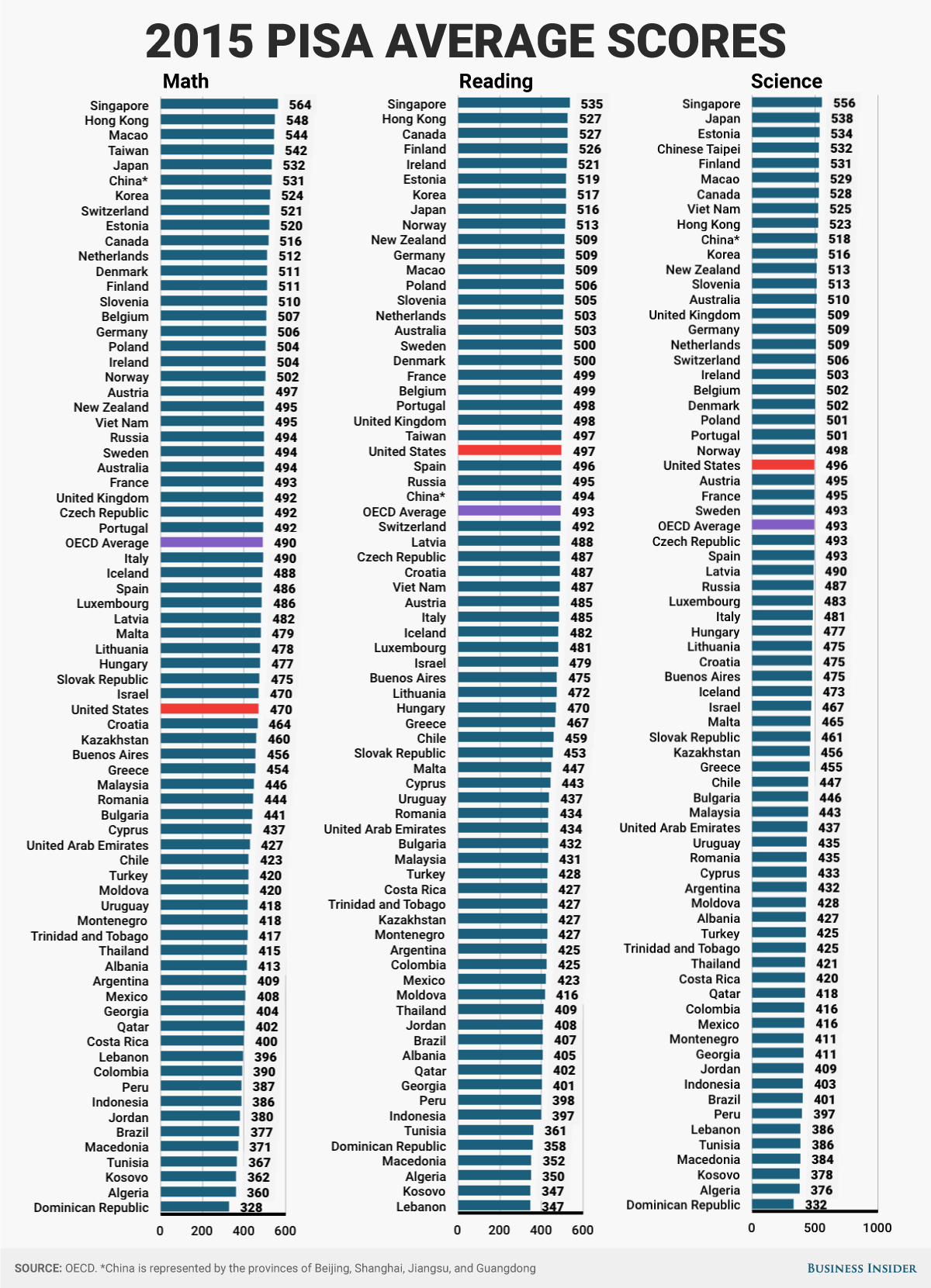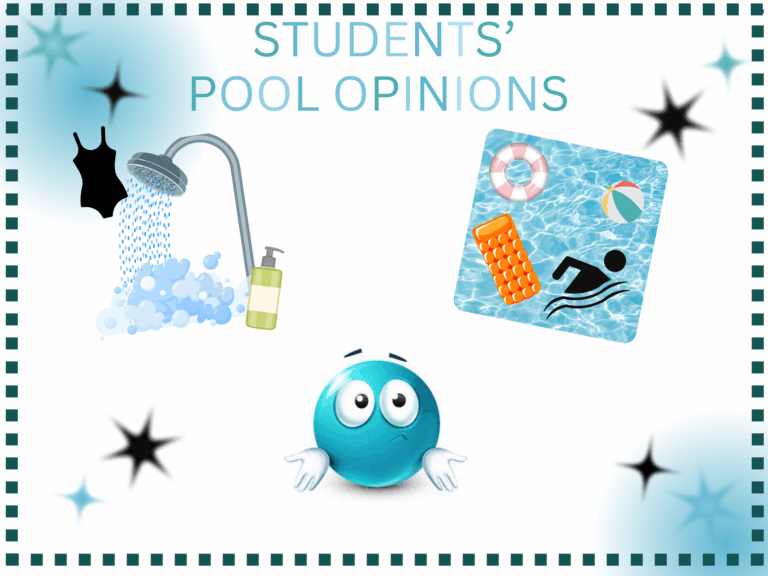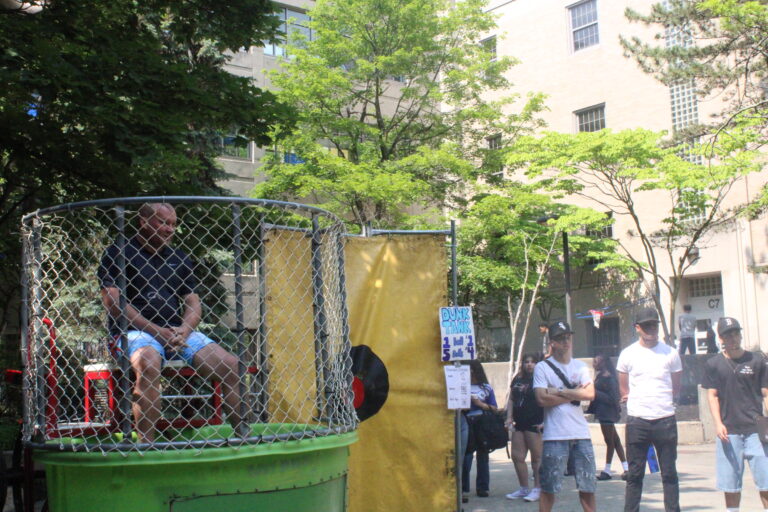
Average PISA scores for 2015. Photo from OECD.
The US education system has definitely improved since classroom learning became more popular than one on one tutoring. However it’s quite a shame to be spending thousands of dollars per student (11,700-26,600 per full-time equivalent student in 2012 depending on whether they go on to post-secondary education) only to receive sub-par scores in math, science, and reading. As of 2015, the US ranked 41 out of 79 in math, 24 out of 79 in reading, and 25 out of 79 in science according to PISA test scores given around the globe. We might not be at the lowest of those scores, such as the Dominican Republic, Kosovo, and Algeria, but we are a leap away from academic leaders such as Singapore, Finland, and China. Besides test scores, we as a nation, struggle with a quarter of all freshmen not completing their high school education, and 30% of all graduating high school students not attending college after.
But test scores don’t matter, it’s who you are that counts… right? Besides academic decrease, schools struggle to fund art and music programs that allow creativity and are a massive part in the development in character of a person. The US has increasing rates of suicide, and not quite the best rates of crime. So, if we can’t at least raise a generation of sound, well rounded, not overwhelmed people, we should aim at improving our academic scores.

That deems two questions: What are we doing wrong? How can we change for the better?
The first question seems easy- everyone has an opinion on what the US system is doing wrong. People say that there’s too much testing. This is true when you consider that Finland has only one required standardized test, while the average American student can take up to 112 standardized test between kindergarten and 12th grade. There’s a bonanza of reasons standardized testing hurting America’s ability to improve. It takes time away from teachers teaching, it puts an extra stress on students, it trains teachers to create a lesson plan based on testing, and they cost a lot of money that could be going to other things. Imagine 1.7 billion dollars going to tackling problems such as child homelessness, and hunger, teachers and art programs.
There are people who believe that it’s the teachers’ faults for our failing students. However teachers are under extreme stress as it is with more information having to be taught with less amount of time every year. Many teachers earn a pay based on how their students do on standardized tests therefore are more inclined to teach testing material rather than material that they want to teach. Teachers are also paid very poorly for the amount of work they have to do because the American mindset is that anyone can teach, possibly due to the view that teaching only requires a master’s degree, therefore is an easy field to get into.
In other countries such as Singapore and Finland, teachers earn the same amount of money (and respect) as doctors and lawyers, while in America, doctors earn up to $100,000 dollars more than teachers yearly. Finnish teachers must also go through rigorous training before being able to teach a class. In Helsinki, Finland, only 7% of applicants were selected to attend Helsinki University to study education, and were selected over a span of 4 days with testing, monitoring, and interviews. Finland is very serious about teaching due to the cultural mindset is that teachers raise the upcoming generation, meaning they must be stellar citizens and role models to their students.
It can also be the way we are teaching students. Besides teachers having to teach information almost purely based on standardized tests, teachers aren’t engaging students, encouraging deeper thinking, or motivating students to try. Singapore’s system is created to engage students and encourage them to find a new way to think about the information. Interestingly enough, Singapore’s top school allows students to use their phones, and social media. Some schools at the moment, especially Malden, allows students to use their phones and laptops to get information, bur are denied access to social media.
Singapore believes that integrating students’ abilities with technology together with learning is much more beneficial as it encourages students asking questions, and spreading information quickly. Although Finland does not permit the use of cellphones, teachers have the freedom to teach however they would like, though are required to have the class involved. Instead of preaching to a crowd, like many American students believe, Finnish teachers find a way to involve students through games and interaction.
There are so many other factors affecting the US school system such as overcrowding, under staffing, student homelessness and hunger, and overwhelming amounts of homework that force students to eventually become exhausted and become unable to retain important information. These factors can be contributed to the massive amounts of money primarily being spent on MCAS, PARCC, SATs, PSATs, etc. and lack of consideration to teachers and students from big testing corporations.
The big ways to solve so many issues can be to have in more trust in teachers, and less in the government who most likely don’t know what students and teachers are able to handle. There’s a great need for equal education. For instance, Finland doesn’t incorporate private schools, and all schools get equal budgets. They also include a system so that all students are fed, well clothed, and taken care of, so that students attend school ready for the day. This creates the equality in education across the country.
In terms of homework, high school students can receive up to 3 or 4 hours of homework a night, and for student athletes who have to balance this with 2 hours of practice or training, this can be a problem leading to lack of sleep, and the feeling of being overwhelmed from the lack of free time. To resolve this, teachers must be able to communicate with each other and agree on a maximum amount of homework time they want their students to focus on. Finland doesn’t give more than 30 minutes of homework to their students, and although this might not be an option for America, we can alter some aspects of school to create a system with less (but still some) homework without overwhelming students.
The current education system is focused on quantity over quality, and not taken seriously by the right people. There needs to be an emphasis on teachers’, and students’ well-being and not on testing. As a nation we can improve so much if the right steps are taken towards the same goal. We can raise a generation of intellectuals, and improve this nation’s pride in education.
The following sources were used for th
is op-ed. For more information, please check out the following links:
http://sites.miis.edu/finlandeducation/class-assignments/
http://hechingerreport.org/how-finland-broke-every-rule-and-created-a-top-school-system/
https://www.youtube.com/watch?v=UfmFIEh2QjU
https://www.youtube.com/watch?v=sEn6OKsVoMs
https://www.youtube.com/watch?v=uOZocYcttO4&t=136s
https://www.ed.gov/news/press-releases/fact-sheet-testing-action-plan
Things related to pisa scores and ed in multiple areas: https://www.youtube.com/watch?v=HN9P8uHEtUg





